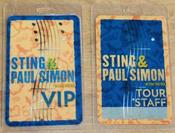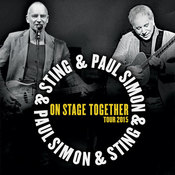
Paul Simon and Sting: On Stage Together
No real lift when Sting and Paul Simon play together...
Paul Simon is 72 years old, Sting ten years younger, both belong to the highest musical elite and at some point the idea came up that they should play together. It is possible that it was a good idea, but if so, it is not entirely well executed.
With the tour "On stage together" they travel around the world with 30 songs from a back catalogue of hits. The prosaic tour title sets the tone. The same interlude and the same song order, probably the same solos every night. And there are a lot of solos. The sixteen-piece band consisting of musicians from their respective touring bands is furiously skilled and gets a lot of space, and it doesn't bother them at all.
But it is sad to hear that Sting and Simon have tired of some of their most beloved songs and therefore let the bursting solos on piano, guitar, tuba, electric violin - what's not here - carry them instead.
That said: nothing is bad in terms of craftsmanship. Sting's "Brand New Day" opens the concert, followed by Paul Simon's "Boy in the Bubble" and an uninspired "Fields of Gold" with Simon on lead vocals. After these opening joint numbers, Simon leaves the stage and Sting's years in The Police are represented by "So lonely" and "When the world is running down" in hard, tight versions. In "Driven to tears" the violinist plays the strings while Sting stands steady and content with the bass on his stomach.
When Paul Simon takes over the stage, everything lightens up. "50 ways to leave your lover" has delicate percussion and something touching emerges. Simon stands in a richer musical culture than Sting with American hymns, Cajun-rooted zydeco, South African choral tradition – all of this is finely woven into the world that he has discovered and adopted. In "Dazzling blue" both the darbuka, a kind of Arabic drum, and the gatam, an Indian ditto, sparkle.
The glow of the concert is found in these lesser-known songs. Paul Simon's joy lies in playing with the musicians and he moves like a fish in water in roots and folk music. Sting's best numbers are also the more evocative "Hounds of Winter" and "The end of the game", when the choir singer Jo Lawry emerges with an impressively confident and strong voice that has not been heard in the pop world for a long time.
Just when I'm wondering how many in the audience have come to hear "Sounds of Silence", the two legendary artists begin to sing "The Boxer". It's like in Göran Palm's poem about the Louvre – yes, there's "The Boxer". Paul Simon is there. But it doesn't lift.
"Me and Julio down by the schoolyard" doesn't lift. "You can call me Al" doesn't lift. The concert doesn't lift. Maybe there are too many fixed phrases that everyone knows how they sound on record: the whistling in Julio, the saxophone in "Englishman in New York". The dear drum beats from the time with Simon & Garfunkel could have been someone else's, Paul Simon does them with a shrug and when Sting turns "America", the simple song that Simon sang so naturally and beautifully in his prime, into a sublime declamation, it feels like sacrilege.
Benny Andersson has answered the recurring question of whether Abba should play again so wisely that people think it would be so fantastic, but it probably wouldn't be as fantastic as people think. You never step into the same river twice.
In line with that, one might have expected Paul Simon and Sting to have written something new, to have sung jazz standards or something from Sting's repertoire with Renaissance composer John Dowland, in short, to have surprised in some way. But the evening ends with the extra numbers "Cecilia", "Every breath you take" and "Bridge over troubled water" in quick succession. Such an audience courtship is a bit too tired from two highly vital musicians.
(c) Svenska Dagbladet by Sofia Lilly Jönsson





